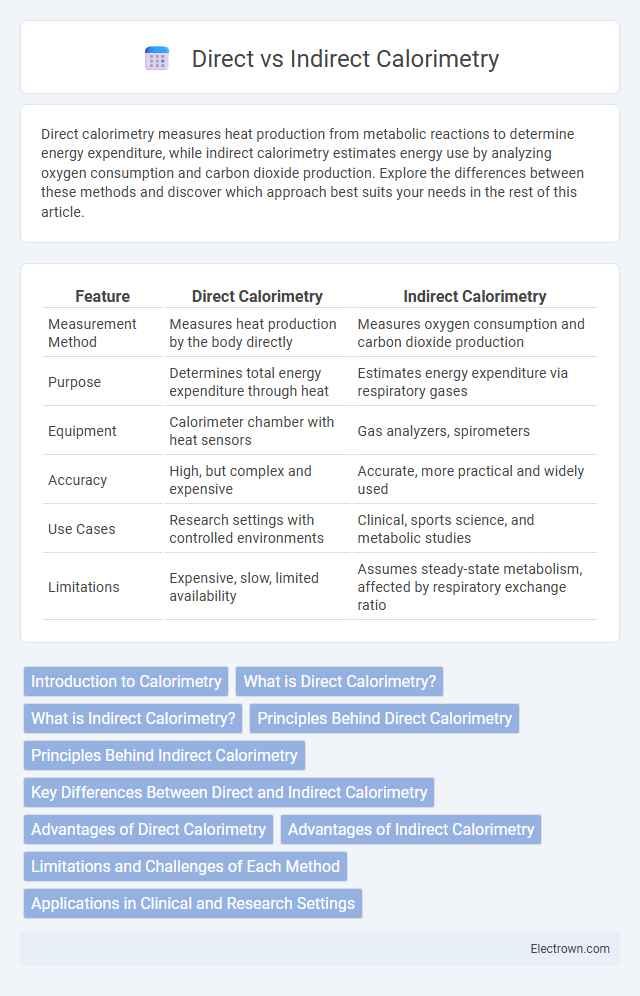Direct calorimetry measures heat production from metabolic reactions to determine energy expenditure, while indirect calorimetry estimates energy use by analyzing oxygen consumption and carbon dioxide production. Explore the differences between these methods and discover which approach best suits your needs in the rest of this article.
Table of Comparison
| Feature | Direct Calorimetry | Indirect Calorimetry |
|---|---|---|
| Measurement Method | Measures heat production by the body directly | Measures oxygen consumption and carbon dioxide production |
| Purpose | Determines total energy expenditure through heat | Estimates energy expenditure via respiratory gases |
| Equipment | Calorimeter chamber with heat sensors | Gas analyzers, spirometers |
| Accuracy | High, but complex and expensive | Accurate, more practical and widely used |
| Use Cases | Research settings with controlled environments | Clinical, sports science, and metabolic studies |
| Limitations | Expensive, slow, limited availability | Assumes steady-state metabolism, affected by respiratory exchange ratio |
Introduction to Calorimetry
Calorimetry measures heat exchange in metabolic processes to estimate energy expenditure. Direct calorimetry quantifies heat released directly from the body using specialized chambers, providing precise data on total metabolic rate. Indirect calorimetry calculates energy expenditure by measuring oxygen consumption and carbon dioxide production, offering practical insights into substrate utilization during metabolism.
What is Direct Calorimetry?
Direct calorimetry measures the heat produced by the body to determine energy expenditure, using a specialized chamber that quantifies heat loss through temperature changes. This method provides precise data on metabolic rate by capturing the actual heat emitted from your body during various activities. Unlike indirect calorimetry, which estimates energy use through oxygen consumption, direct calorimetry offers a direct measurement of thermal energy output.
What is Indirect Calorimetry?
Indirect calorimetry measures energy expenditure by analyzing oxygen consumption (VO2) and carbon dioxide production (VCO2), providing insights into metabolic rates and substrate utilization. It uses respiratory gas exchange data to estimate caloric burn without directly measuring heat output. This method is widely applied in clinical nutrition, exercise physiology, and metabolic research due to its non-invasive nature and accuracy in assessing basal metabolic rate (BMR) and total energy expenditure (TEE).
Principles Behind Direct Calorimetry
Direct calorimetry measures metabolic rate by quantifying the heat produced by an organism, utilizing a calorimeter chamber that detects infrared energy emitted as heat. The principle relies on the conservation of energy, where all metabolic energy ultimately converts to heat, which is captured and measured by temperature-sensitive sensors or water flow changes. This method provides a precise assessment of total energy expenditure by directly monitoring heat exchange with the environment.
Principles Behind Indirect Calorimetry
Indirect calorimetry measures energy expenditure by assessing oxygen consumption (VO2) and carbon dioxide production (VCO2), which reflect metabolic rate and substrate utilization. It relies on the respiratory exchange ratio (RER) to estimate the proportion of carbohydrates and fats being oxidized during metabolism. Understanding these principles allows you to accurately gauge your body's energy balance and fuel use without the need for direct heat measurement.
Key Differences Between Direct and Indirect Calorimetry
Direct calorimetry measures heat production by capturing thermal energy emitted from the body, providing a direct assessment of metabolic rate through temperature changes in a controlled environment. Indirect calorimetry estimates energy expenditure by analyzing oxygen consumption and carbon dioxide production, reflecting the biochemical oxidation of substrates. Key differences include the direct measurement of heat in direct calorimetry versus gas exchange analysis in indirect calorimetry, with indirect methods offering greater practicality and less complexity for metabolic studies.
Advantages of Direct Calorimetry
Direct calorimetry measures the actual heat produced by the body, providing highly accurate data on energy expenditure. It allows precise calculation of metabolic rate by capturing total heat output, making it ideal for controlled experimental settings. Your research benefits from this method's ability to minimize estimation errors common in indirect techniques.
Advantages of Indirect Calorimetry
Indirect calorimetry offers several advantages, including its non-invasive nature and ability to measure energy expenditure by analyzing oxygen consumption and carbon dioxide production. This method provides accurate metabolic data during various activities and is more practical and cost-effective compared to direct calorimetry, which requires specialized equipment to measure heat production. You can utilize indirect calorimetry for continuous monitoring in clinical and research settings, making it ideal for assessing metabolic rates.
Limitations and Challenges of Each Method
Direct calorimetry faces challenges related to its high cost, complex equipment, and the need for specialized facilities to measure heat production accurately. Indirect calorimetry, while more accessible, is limited by assumptions about substrate oxidation and inaccuracies in estimating energy expenditure during non-steady-state conditions. Both methods encounter difficulties in capturing real-time metabolic changes and can be influenced by environmental factors or subject movement, impacting data reliability.
Applications in Clinical and Research Settings
Direct calorimetry measures heat production to assess metabolic rate, widely used in clinical settings for evaluating energy expenditure in patients with metabolic disorders. Indirect calorimetry estimates energy expenditure by analyzing oxygen consumption and carbon dioxide production, making it essential for nutritional assessment and monitoring critically ill patients. Both methods are fundamental in research for studying human metabolism, exercise physiology, and the effects of interventions on energy balance.
Direct vs Indirect Calorimetry Infographic

 electrown.com
electrown.com